History of Addis Ababa
The history of Addis Ababa, capital of Ethiopia, formally begins with the founding of the city in the 19th century by Ethiopian Emperor Menelik II and his wife Empress Taytu Betul. In Middle Ages, Addis Ababa depicted as a fortified city named "Barara", and served as residence of Emperor of Ethiopian Empire until Dawit II. It was totally plundered by Adalite general Ahmed Gran in 1529, at the onset of Ethiopian–Adal War.
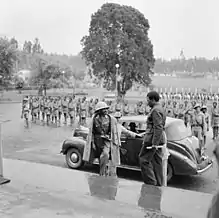
Prior to the establishment of present-day Addis Ababa the location was called Finfinne in the Oromo language, which attests the presence of hot springs. The area was inhabited by various Oromo clans.[1][2]
Prehistory
A DNA studies shows from 1,000 people that humans began migrating from Addis Ababa vicinity around the globe for 100,000 years.[3] Other studies confirmed that Africans have more diverse gene than other continents, but new research indicated genetic diversity declination steadily happens while ancestors travelled to Addis Ababa, which roughly a site of exiting "out of Africa" migration.[4] Science journal offered a deductive evidence that ancient explorers emerged from the region to colonized the rest of continents. Similarity, the Nature published that the greater geographic distance between a population and its African ancestors, the more accumulated gene changes occurs.[3]
Middle Ages
Barara, a medieval prosperous fortified city, dated to mid-16th century, served a basis of commerce centre. It also served a residence of Ethiopian royal lords and emperors until Dawit II, diplomats and even for church leaders. The notability of this city led an inclusion of world map. Corroborating evidence found in debris found in Addis Ababa vicinity, with footnotes and correspondence with scholastic works. Notable scholars in this subject include Bretenits, Richard Pankhurst, Falchetta, and Fra Mario in his world map. Subsequently, contemporary scholars such Professor Getatchew Haile's published and unpublished account those medieval findings. Barara almost fully sacked by Adalite general Ahmed ibn Ibrahim al-Ghazi (Ahmed Gran) during the Ethiopian–Adal War in 1529; within 14 years, he burnt several churches, historical books, antiques item of Barara, killing thousands people, and stole gold, silver and silicon furnishing.[5]
19th-century
Prelude
Regarding the foundation, Mount Entoto has been a watershed for establishment of Addis Ababa. Addis Ababa is surrounded by Entoto to the north, Yerrer to the east, and the most prominent Menagesha to the west. The area generally served as a garrison town of which generals allocated an encampment (safar) to settle troops.[6] According Wolde-Mariam (1976), urbanization faced formidable problems due to large-scale conflict with warlords, which converted into garrison town.[7]
Prior to the establishment of present-day Addis Ababa the location was called Finfinne in the Oromo language, which attests the presence of hot springs. The area was inhabited by various Oromo clans, but assertion that supports Oromo possession of the city has met with false claim.[5][8] After Taytu and Menelik got interested to the beautiful land scape[9] Before the advent of Addis Ababa, there were many sites in the surrounding areas that had been used as temporary capitals for the Kingdom of Shewa. Ankober, a site about 160 km north of Addis Ababa, served as the capital of the kingdom of Shewa during the second half of the 18th century. As evidence, the ruins of the palace are still found on the lip of the great escarpment, which is popular in its breath-taking view. The village of Aliyu Amba, which was the most important market center of the Shewa Kingdom, is also located below Ankober palace at one of the broken hills. Other areas, like Wechecha, Yerrer and Entoto were also temporarily used as capitals of the Shewan Kingdom.[10][11]
Early vicinity settlements
Menelik, as Negus[nb 1] of Shewa, had found Mount Entoto a useful base for military operations in the south of his realm. In 1879, Menelik visited the reputed ruins of a medieval town and an unfinished rock church that showed proof of an Ethiopian presence in the area prior to the campaigns of Ahmad Gragn. His interest in the area grew when his wife Taytu began work on a church on Entoto. In addition, Menelik endowed a second church in the area.
In 1881, Menelik moved the capital of Shewa from Ankober to Entoto.[12] A relocation of imperial nobilities and armies shaped political atmosphere. In addition, there was also a categorization of the imperial army at the time; fitawrari, loyal to Menelik's expansionism, thrusts to the west and south; on the right wing of the army, to the north, lay the safar of his powerful generals and his cousin, Mekonnen; on the left wing, to the south, lay lesser generals and to the east protect the rear of army lay the palace of dejazemach or commander of rearguard. Between them were scattered subordinates and lesser nobility.
Major safar was expanse that delimited rival army and prevents from potential clashes. Other factors that give boundary was the presence of streams and deep gorges, including the Kebenna, Kechene, Qurtume, and a small Akaki River. There were also a marketplace in the mid area led by Negadrass and was home of foreign elite community; mostly French, Armenians and Indians citizens. The original land charter identified safar besides parishes (atbiya) into division into sections. However, with the presence of military, safar always important than atbiya for locating the city.
Founding
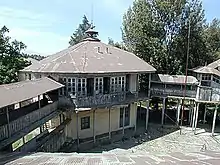
The immediate area around Entoto did not encourage the founding of a town due to the lack of firewood and water. In 1886, the actual settlement began in the valley south of the mountain. Taytu initially built a house for herself near the Filwoha hot mineral springs, where she and members of the Shewan royal court liked to take mineral baths. Soon, other members of the Shewan nobility and their staffs and households settled the vicinity.
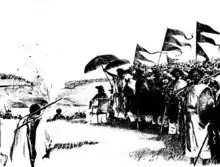
Negus Menelik expanded his wife's house to become the Imperial Palace, which remains the seat of government in Addis Ababa today. Between 1889 and 1891, Addis Ababa became capital of Ethiopian Empire when Menelik II became Emperor of Ethiopia. One of Emperor Menelik's contributions that is still visible today is the planting of numerous eucalyptus trees along the city streets.[11][10] After 1896, the city slowly transformed from military encampment to civilian town. When this happens, travellers and sportsmen often commented look like a "vast camp" or "collection of village" rather than what they perceived town.[6]
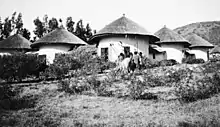
After becoming the capital of Ethiopian Empire, Addis Ababa grew by leaps and bounds and took on the character of a boomtown. By 1910, the city had approximately 70,000 permanent inhabitants and also had between 30,000 and 50,000 temporary inhabitants. Addis Ababa became the site of many of Ethiopian innovations. Because of the sizeable population of Addis Ababa, a degree of labor specialization not seen elsewhere in the empire was possible.[13] The rapid growth of Addis Ababa, especially soon after the Battle of Adwa, was accompanied by the construction of some of Ethiopia's first modern bridges.[14] Early its founding, foreigners had an interest to complement as metropolitan, by expanding buildings. Much of its settlement consisted of hut complex, constructed with mud and straw plastered on wooden frame, and thatched roofs. The city further transformed rapidly without planned intention.[7] According to Richard Pankhurst (1968), population growth increased as a result of factors related to provisional governments and their troops, the 1892 famine and the Battle of Adwa. After the Ethio-Djibouti Railways laid, Addis Ababa expanded it's boundary more to southward.
20th-century
Pre-Italian occupation (1916–1935)
Ras Tafari, later became Emperor Haile Selassie had a considerable influence in the city after his appointment in 1917. He raised awareness for modernization by distributing wealth to emerging class. Gebra Heywat started occupying the major administritive division post, as he ruled as inspector of Addis Ababa—Djibouti railway in 1916,[15] which also connects Addis Ababa with French Somaliland port of Djibouti.[16]
By 1926 and 1927, Addis Ababa saw economic revolution, a surplus of coffee production was growing as a result of capital accumulation. In addition, the bourgeoisie benefited the city with large income of goods. They constructed new, stone-fitted house with imported European furniture and an importation of latest automobile, and expansion of banks across the locales.[17] Total register automobiles were 76 in 1926, and summed up to 578 in 1930.[18]
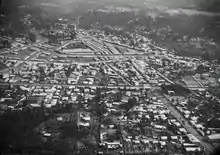
Road transportation were very unpopular to the city and the country until the opening of Addis Ababa—Djihour Ridge, about 97 miles northward in the direction of Dessie. This road was considered the longest continuous motor route, which initially connecting Italian occupied Assab in Eritrea and Addis Ababa via Dessie as accorded to Italo-Ethiopian Treaty of 1928. The highway were very important to French owned railway of Djibouti because of freight rate were very high caused by lack of competition, and believed that considerable amount of cargo would be increase between Ethiopia and Assab. Significant merchants of Addis Ababa were received by Tafari Mekonnen on 18 November 1929, to deal with road extension. The government's Gazette newspaper highlighted road expansion frequently and published through French weekly newspaper.[19]
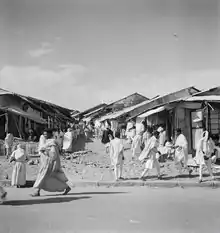
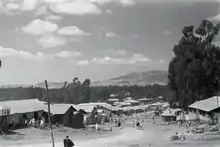
After crowned as Emperor, Haile Selassie issued with propelling further development of infrastructures such as importing power lines and telephone, and erecting several monuments.[17]
Post-Italian occupation (1941–1974)
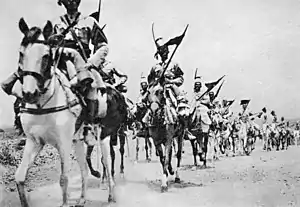
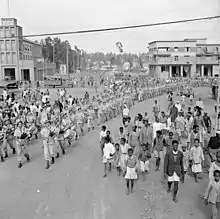
On 5 May 1936, Italian troops occupied Addis Ababa during the Second Italo-Abyssinian War, making it the capital of Italian East Africa. Addis Ababa was governed by the Italian Governors of Addis Ababa from 1936 to 1941. In those five years the Italian government made many improvements to the city, from the construction of hospitals and roads to the creation of stadiums like the Addis Ababa Stadium.[20] The war of aggression resulted heavy aerial bombardment of the city, and along with future chartered Dire Dawa; the use of chemical weapons such as mustard gas constituted the Italian atrocities. The most lethal chemical weapons include sulphur mustards and spray tanks; the former could be the worst to sabotage the Ethiopian armies. According to the Soviet estimates, 15,000 Ethiopians causalities were victim of chemical weapons.[21] Throughout their occupation, trade routes increasingly became spatial growth; in the last quarter of the century, Addis Ababa experienced profound road and trade route; opening the pavement to Adama and the Ethio-Djibouti trade corridor to the north of Ethiopian cities, Moyale with Kenyan territories to the southwest, and trade route with Sudan to the west. Addis Ababa influenced social milieu of Oromia Region because of construction of surrounding small towns incorporated to one special zone.
After the Italian army in Ethiopia was defeated by the British army (with the help of Arbegnoch[nb 2]), during the Liberation of Ethiopia, Emperor Haile Selassie returned to Addis Ababa on 5 May 1941—five years to the very day after he had departed—and immediately began the work of re-establishing his capital.[11][10] It was abandoned in favor of Amba Alagi and other redoubts during the war.
Within twenty years, Addis Ababa sought transformation and attracted by foreign investors, traders, and the Ethiopian diaspora aboard. In aftermath, both French and British consultant started master plan to extirpate weakened area. However, the plan was not successful at all costs in cases of traditional administration and land distribution. By 1960, the city completed as Luis De Marien's plan implementation to beautify the city with huge landmarks.[22]
Emperor Haile Selassie helped form the Organization of African Unity in 1963, and invited the new organization to keep its headquarters in the city. The OAU was dissolved in 2002 and replaced by the African Union (AU), also headquartered in Addis Ababa. The United Nations Economic Commission for Africa also has its headquarters in Addis Ababa. Addis Ababa was also the site of the Council of the Oriental Orthodox Churches in 1965.[11] [10][23] According to Pankhurst (1962) survey, 212 square kilometers, 58% of total land were owned by 1,768 persons, owing to 10,000 square meters. 12% of area were given for churches. Some areas still posthumously entitled by members of various nobilities of that time: such as Dejazemach Wube Haile Mariam, Fitawrari Aba Koran, and a bridge named "Fitawrari Habtegiorgis" after Habte Giyorgis Dinagde.[7]
Population density greatly affected the city with unregulated manner; according to Wubshet (2002), two-third buildings inappropriately constructed without proper master plan, designs were perplexed.
The Haile Selassie regime faced backlash—as evident of 1960 coup d'etat attempt—from various reactionary partisans. In 1965, Haile Selassie I University, later Addis Ababa University students marched chanting "Land to the Tiller" as a response of the imperial feudal system, culminating in series revolutionary protests across Addis Ababa, and ushering Marxist–Leninist momentum.[24]
The Derg administration (1974—1991)
After overthrow of Emperor Haile Selassie by communist Derg in 1974, roughly two-third of the housing stock transferred to rental housing. In 1975, the Derg nationalized all "extra" rental structures built by private stockholders. If those rental properties value less than 100 birr (48.31 USD), they would be put under kebele administration.[7] The 1986 Italo-Ethiopian master plan and the Revised Master Plan of 2002 aspired by polycentric with multiple districts.[25]
Under Proclamation No 47/1975, small building owed to kebele units, whereas large quality rental houses to Agency for Rental Housing Administration (ARHA). However, it was not successful at all; informal constructions, and renewal, or expansion extended to inner-city. In addition, nationalized lands underwent poor management as a result of low tenancy that cannot be overhaul. The 1986 master plan dealt with renewal of most part of inner-city that contain kebele houses. Indeed, the plan could bring backward that tolerate the chika (mud) house.
One of the most noticeable strife that the city ever seen include the Red Terror (Qey Shibir) which took a place between 1976 and 1978, a bloody repressive campaign executed by the Derg members against its rival opposition groups like, Ethiopian People's Revolutionary Party (EPRF) as a response to perceived assassination.
By mid-1990s, more than 40% of Addis Ababa stock administered by joint ARHA and kebele units.
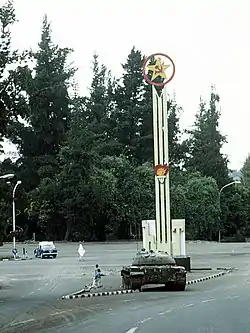
On 28 May 1991, the Ethiopian People's Revolutionary Democratic Front (EPRDF) coalition party in course of overthrowing the Derg government, seized Addis Ababa. According to witness, resident were not terrorized by the event and a militant remarked "We think it's safe now". They engulfed the central place of city such as Hilton Hotel, displaying a banner read as "Peace, Solidarity, Friendship". At 5:30 am, they completely controlled the presidential area and large-scale tanks were seen overrun.
Federal Democratic Republic (1991–present)
Reforms were largely reversal of nationalized properties. A new constitution was adapted in 1994 and enacted a year later: while all cities in Ethiopia administrated by regional authority, only Addis Ababa (Proclamation No 87/1997) and Dire Dawa (Proclamation No 416/2004) remain chartered cities, mandates for self-governing and developmental center, partly because of incipient international organizations and a "melting pot" national culture.[26]
21st-century
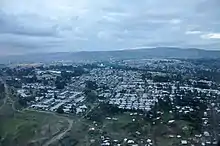
.jpg.webp)
In 2005 general election, the government promised to bring the city into further urban focused development. Subsequently, many programs were designated including Urban Development Policy of Ethiopia and Sustained Development Policy of Ethiopia (PASDEP), aiming for "driving force of national development". Those program allowed wide-scale development into transforming the city.
2014 Addis Ababa Master Plan
A master plan for Addis Ababa boundary expansion with 1.1 million hectares into the Oromia special zone sparked violent crackdowns and Oromo-led protests since 25 April 2014.[27][28] After deadly protests were conducted that led numerous causalities in Addis Ababa and Ginchi town,[29][30][31] the controversial plan finally cancelled on 12 January 2016. By that time, 140 protestors were killed.[32][33][34]
United Nations Population Projections estimated metro area of Addis Ababa 5,228,000 in 2022, a 4.43% increase from 2021.[35]
See also
Notes
- Roughly equivalent to King.
- Equivalent to Ethiopian patriots.
References
- Endalew Djirata Fayisa. "Foundation of Addis Ababa and the Emergence of Safars".
- Foundation of Addis Ababa and the Emergence of Safars, retrieved August 20, 2020
- "DNA Studies Trace Migration from Ethiopia". bnd.com. St. Louis: Los Angeles Times. bnd. 22 February 2008. Archived from the original on 20 October 2007. Retrieved 20 July 2021.
- Brown, David (22 February 2008). "Genetic Mutations Offer Insights on Human Diversity". The Washington Post. Archived from the original on 4 June 2011. Retrieved 23 April 2010.
- "Barara -Addis Ababa's Predecessor: Foundation, Growth, Destruction and Rebirth (Book Review)". Borkena Ethiopian News. 2020-06-24. Retrieved 2022-04-02.
- Garretson, Peter P. (1974). A History of Addis Ababa from Its Foundation in 1886 to 1910. Otto Harrassowitz Verlag. ISBN 978-3-447-04060-0.
- Alemayehu, Elias Yitbarek; Stark, Laura (2018-11-30). The Transformation of Addis Ababa: A Multiform African City. Cambridge Scholars Publishing. ISBN 978-1-5275-2272-5.
- Endalew Djirata Fayisa. "Foundation of Addis Ababa and the Emergence of Safars".
- Indigenous Oromo Community Currently Living around the Addis Ababa
- "Addis Abeba in "Enciclopedia dei ragazzi"". www.treccani.it.
- "Addis Ababa - national capital, Ethiopia".
- Pankhurst, p. 195
- Pankhurst, p.195
- Pankhurst, p. 196
- Zewde, Bahru (2002). Pioneers of Change in Ethiopia: The Reformist Intellectuals of the Early Twentieth Century. J. Currey. ISBN 978-0-85255-452-4.
- Daily Consular and Trade Reports. Department of Commerce and Labor, Bureau of Manufactures. 1927.
- Anacker, Caelen (2010-03-16). "Addis Ababa, Ethiopia (1886– ) •". Retrieved 2022-01-05.
- Friedson 1930, p. 24.
- Freidson, Irving (1930). Motor Roads in Africa: (except Union of South Africa). U.S. Government Printing Office.
- Podesta: "Family and Society in Italian Africa"
- Weapons of War: Environmental Impact: Environmental Impact. KW Publishers Pvt Ltd. 2013-08-15. ISBN 978-93-85714-71-9.
- Dawit Benti Erena; Abnet Gezahegn Berhe; Imam Mahmoud Hassen; Tsion Lemma Mamaru; Yonas Alemayehu Soressa (2017). City Profile: Addis Ababa (PDF) (Report). Addis Ababa: Erasmus+ Program of the European Union; EiABC. [Report prepared in the SES (Social Inclusion and Energy Management for Informal Urban Settlements) project].
- "Addis Abeba, Ethiopia" (PDF). inura.org.
- Zewde, Bahru (2014). The Quest for Socialist Utopia: The Ethiopian Student Movement, C. 1960-1974. Boydell & Brewer Ltd. ISBN 978-1-84701-085-8.
- Alemayehu, Elias Yitbarek; Stark, Laura (2018-11-30). The Transformation of Addis Ababa: A Multiform African City. Cambridge Scholars Publishing. ISBN 978-1-5275-2272-5.
- "Addis Ababa City Government Revised Charter Proclamation" (PDF). Federal Negarit Gazeta. 22 April 2022.
- Ethiopia's 'Master Plan' – good for development, damaging for minorities, 12 August 2014, retrieved 12 August 2014
- The Roots of Popular Mobilization in Ethiopia, 16 June 2017, retrieved 16 June 2017
- OROMO PROTESTS: DEFIANCE AMIDST PAIN AND SUFFERING, 16 December 2015, retrieved 16 December 2015
- Ethiopia: Lethal Force Against Protesters, 18 December 2015, retrieved 18 December 2015
- Country Policy and Guidance Note Ethiopia Oromos including the Oromo Protests (PDF), November 2017
- Ethiopia Scraps Plan for Capital Area that Sparked Protests, retrieved 13 January 2016
- Ethiopia scraps Addis Ababa 'master plan' after protests kill 140, 14 January 2016, retrieved 14 January 2016
- "Ethiopia cancels Addis Ababa master plan after Oromo protests", BBC News, 13 January 2016, retrieved 13 January 2016
- "Addis Ababa, Ethiopia Metro Area Population 1950-2022". www.macrotrends.net. Retrieved 2022-04-17.
Bibliography
- Pankhurst, Richard (2001). The Ethiopians: A History (Peoples of Africa). Wiley-Blackwell; New Ed edition. ISBN 0-631-22493-9.
External links
 Media related to History of Addis Ababa at Wikimedia Commons
Media related to History of Addis Ababa at Wikimedia Commons